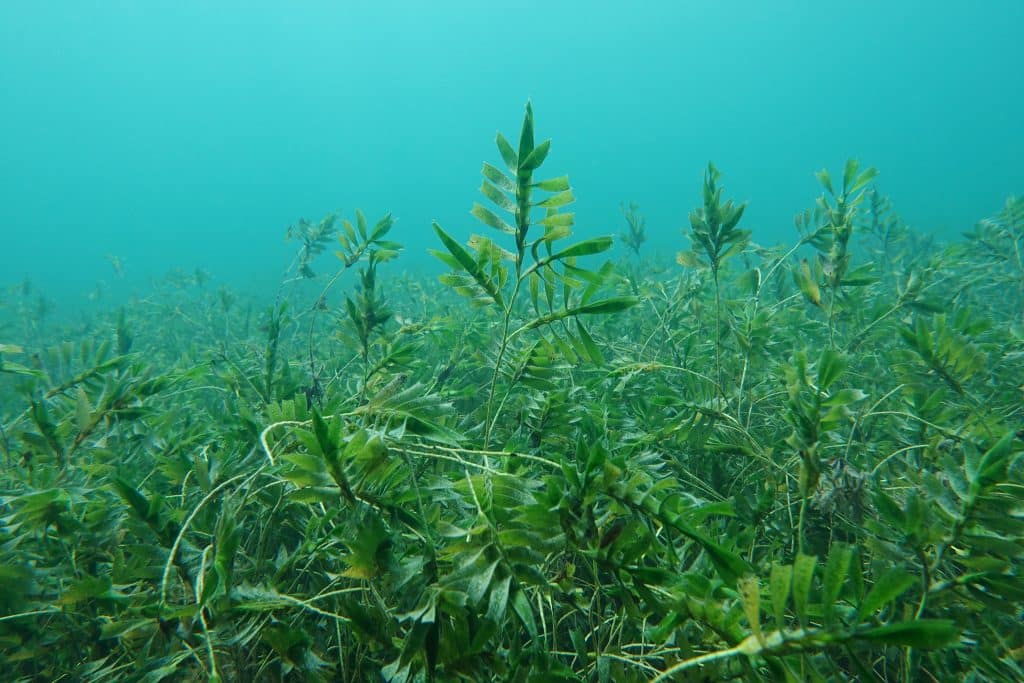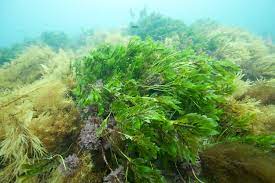HABITAT AND GEOGRAPHIC RANGE
The Sea Nymph can be found all along the Australian coastline from the Exmouth Gulf in the north-west of Australia through to Victoria. The grass usually grows within a depth of 27 metres in the littoral and sublittoral zones (areas close to the shore affected by breaking waves and tidal currents) in meadows. It has a large tolerance range of depth and can withstand strong movement within the water, making it ideal for the Southern Ocean’s wild and stormy seas.
It attaches itself to limestone, clay or granitic substrates as well as gravel and sand. It can live in extremely saline water, making it a very hardy plant. Chatham island has a granite under-water slope and a few sandy areas as well that would be ideal for the Sea Nymph. Although waves often break violently against the island, some areas—particularly the northern side—are more protected.
Despite the Sea Nymph being able to inhabit highly turbulent waters, it is more likely the population would be denser, or at least existent, in these areas. Distribution is clumped, as the grass can only attach itself to certain substrates at certain depths, as well as compete with other grasses.
DESCRIPTION
A rhizome (modified stem in which the plant shoots off from) mat allows the plants to attach themselves to crevices and colonise rocky areas, as well as establish roots in sand. Rhizome stems are round and 2-3mm thick in diameter, whereas erect stems are between 1-1.5mm (depending on age). Roots are generally fine and wiry. Leaves come off branches, with 6-8 leaves on each side.
They are attached in an alternate pattern to the branch (the node on one side is not directly opposite the node on the other) and overlap (the ‘lower’ leaves will rest on top of ‘higher’ leaves). The blade is flat with a series of small ribs, rather than a midrib and comes out of a lamina (sheath) on the branch (sometimes the sheath is wider than the blade though this is generally not the case). At the end of each leaf, there are two ‘teeth’—as if two small inserts have been cut out. Individual leaves can be 5cm long and stems can grow to 80cm.
| CLASSIFICATION | |
| Domain | Eukarya |
| Kingdom | Plantae |
| Phylum | Charophyta |
| Class | Equisetopsida |
| Subclass | Magnoliidae |
| Order | Alismatales |
| Suborder | Lilianae |
| Family | Cymodoceaeae |
| Genus | Amphibolis |
| Species | antarctica |
NUTRIENT PREFERENCES / GROWING CONDITIONS
Being autotrophic Sea Nymphs require light and so stay within the photic zone. The Southern Ocean contains high amounts of nutrients, as do littoral zones, so the Sea Nymph has a high nutrient intake. Being marine it also requires high salinity. They are usually the first to colonise denuded or barren areas and do not require much nutrients in the soil. Sea Nymphs do not require much organic carbon input from other species, with nutrients supplemented by their own detritus. Compared to other seagrass species, grasses in the Amphibolis genera require less organic carbon.
FOOD CHAIN
Sea Nymphs have several seed predators including isopods and portunid crabs. Other herbivores include snails of the genera Phasianella, as well as some fish species. Herbivory is common between May and July. As they are one of the primary producers of Southern Ocean ecosystems, most other species in the chain rely on them for energy and nutrients. They also perform nutrient cycling and create a unique habitat for smaller species.
LIFE CYCLE
There are several ways in which these plants reproduce, one is through clonal growth. Sea Nymph branches and stems are held together by a rhizome and root mat, new seedlings form when a young stem detaches from the mat. When this happens, the seedling will drift (sometimes great distances) and then attach itself to another substrate with a comb—a ‘grappling apparatus’.
These seedlings are called genets as they are a result of asexual reproduction. Depending on the age and health of the plant, new stems will shoot and detach themselves at an average rate of 1.5/year. Clonal growth is the main method of reproduction in Western Australian meadows, but it does depend on sexual reproduction and therefore the number of flowering plants. Amphibolis antarctica is a perineal monocot, flowering from September to February with green flowers.
There are male and female plants with different reproductive organs, meaning the Sea Nymph is dioecious. Once seeds are fertilised, they germinate, attaching to the mother plant for 7-12 months before they detach themselves (they develop an abscission layer so the mother isn’t damaged) and start a new plant. This method is called vivipary, as the seedling develops before leaving the parent plant. Most shoots will live under two years.
REFERENCES
Investigating Marine Life, Quadrat Sampling, Census of Marine Life (2009). Available at: http://www.coml.org/investigating/observing/quadrat_sampling.html (retrieved on: 15/4/21)
Vivipary, Science Direct (2021). Available at: https://www.sciencedirect.com/topics/agricultural-and-biological-sciences/vivipary
What is the Difference Between Dioecious and Monoecious Plants?, The Spruce (02/02/2020). Available at: https://www.thespruce.com/difference-between-dioecious-and-monoecious-plants-2131039 (retrieved on: 15/4/21)
Amphibolis antarctica, Vicflora. Available at: https://vicflora.rbg.vic.gov.au/flora/taxon/ffd4439b-a0d7-4238-973e-8026ca295219#&gid=1&pid=1 (retrieved on: 15/4/21)
Principles of Ecology, Phil Ganter (03/02/2007). Available at: https://ww2.tnstate.edu/ganter/B412%20L09%20Populations.html (retrieved on: 15/4/21)
Predation on Posidonia australis seeds in seagrass habitats of Rottnest Island, Western Australia: patterns and predators, R.J. Orth, Gary Kendrick, S.R. Marion, UWA (2006). Available at: https://research-repository.uwa.edu.au/en/publications/predation-on-posidonia-australis-seeds-in-seagrass-habitats-of-ro (retrieved on: 15/4/21)
Latitudinal variation in seagrass herbivory: Global patterns and explanatory mechanisms, Adriana Verges, Christopher Doropoulos, WILEY (09/11/2017). Available at: https://onlinelibrary.wiley.com/doi/pdf/10.1111/geb.12767 (retrieved on: 15/4/21)
Can mud (silt and clay) concentration be used to predict soil organic carbon content within seagrass ecosystems? Oscar Serrano, Paul S. Lavery. Biogeosciences EGU. Available at: https://bg.copernicus.org/articles/13/4915/2016/bg-13-4915-2016.pdf (retrieved on: 15/4/21)
Parts of a leaf, Oak Leaf Gardening (2021). Available at: http://www.oakleafgardening.com/glossary-terms/parts-of-a-leaf/ (retrieved on: 15/4/21)
Alternate leaf arrangement, Encyclopaedia Britannica. Available at: https://www.britannica.com/science/alternate-leaf-arrangement (retrieved on: 15/4/21)
Amphibolis antarctica, eFloraSA, State Herbarium of South Australia (2007). Available at: http://www.flora.sa.gov.au/efsa/Marine_Benthic_Flora_SA/Part_I/Amphibolis_antarctica.shtml (retrieved on: 15/4/21)
Global Change, Clonal Growth, and Biological Invasions by Plants, Fei-Hai Yu, S.R. Roiloa (29/09/16). Available at: https://www.frontiersin.org/research-topics/3914/global-change-clonal-growth-and-biological-invasions-by-plants (retrieved on: 15/4/21)
Rhizomes: Definition, Examples, The Spruce, (10/11/19). Available at: https://www.thespruce.com/rhizomes-definition-examples-2131103 (retrieved on: 15/4/21)
Growth, flowering, and population dynamics of temperate Western Australian Seagrasses, Nuria Marba, Diana Walker, Marine Ecology Progress Series (28/07/99). Available at: http://www.int-res.com/articles/meps/184/m184p105.pdf (retrieved on: 15/4/21)
Amphibolis antarctica, Museums Victoria. Available at: https://collections.museumsvictoria.com.au/species/15191 (retrieved on: 15/4/21)
Sea Nymph, Atlas of Living Australia. Available at: https://bie.ala.org.au/species/https://id.biodiversity.org.au/node/apni/2908677#overview (retrieved on: 15/4/21)
Plant of the Month: The Sea Nymph, Know Our Plants (?/01/17). Available at: https://know.ourplants.org/the-plant-press/plant-of-the-month-jan-2017/ (retrieved on: 15/4/21)


